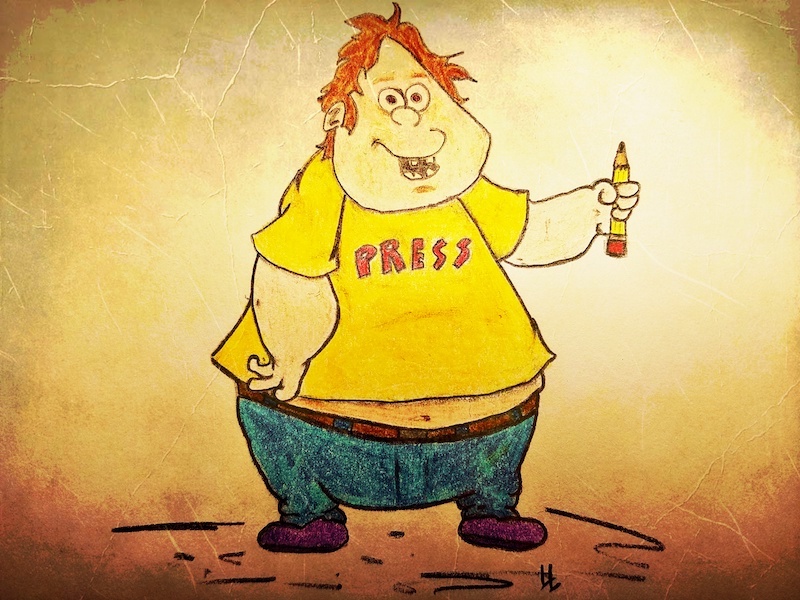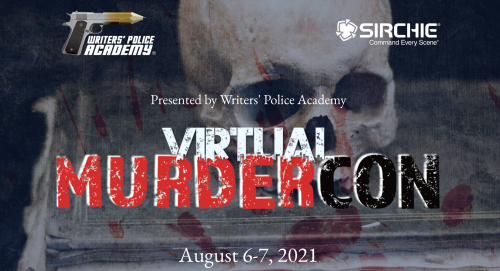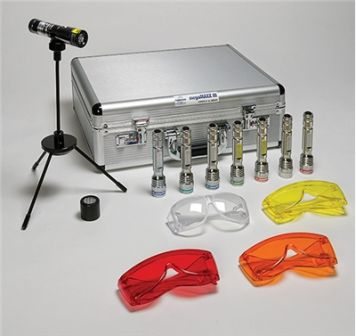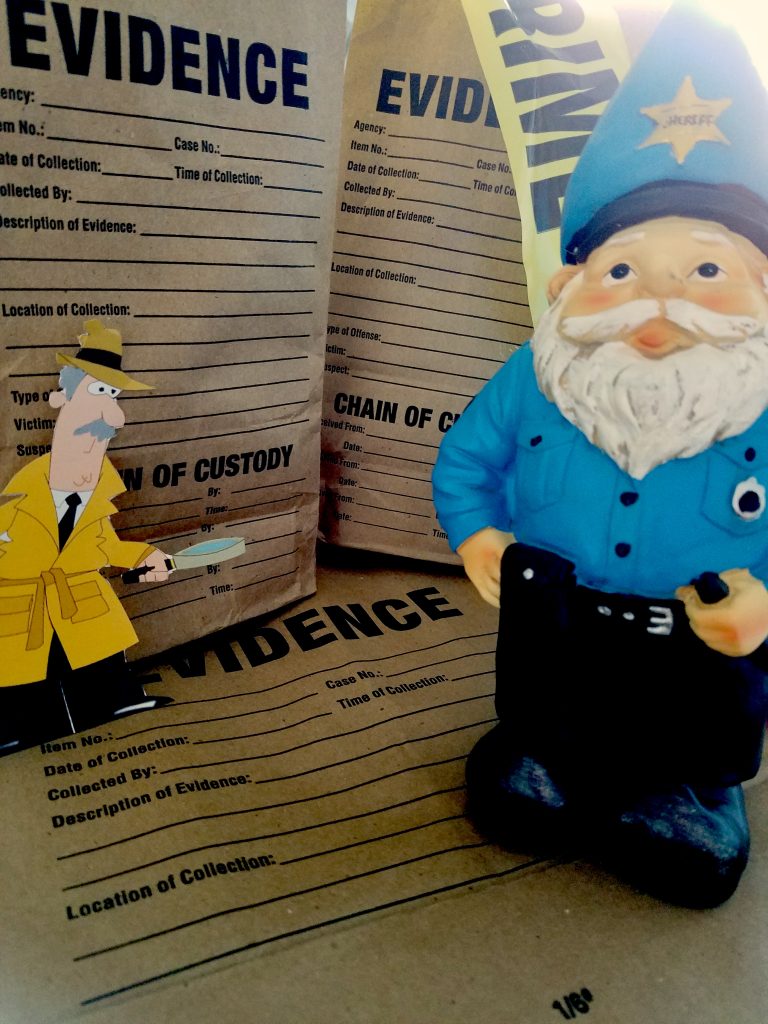Superhuman strength, aggression, violence, paranoia, yelling, bizarre behavior, and hyperthermia. Those are some of the symptoms of a person in a state of Excited Delirium, a condition that can, especially when combined with drug use, result in death.
Excited delirium, aka Bell’s mania, lethal catatonia, acute exhaustive mania, and agitated delirium, typically surfaces suddenly, without warning, and can be extremely terrifying to bystanders and family members. The condition is extremely tricky for law enforcement and other first responders who may not have received proper training for handling people in this state.
A person experiencing a bout of excited delirium (EXD) may experience an alarmingly high heart rate, incoherence, suicidal thoughts, hallucinations, and body temperature to go as high as 108 degrees Fahrenheit. They often feel so hot (hyperthermia) that they disrobe in an attempt to cool down. Similar conditions are seen in people who use/abuse Bath Salts.
Other signs and symptoms may include fear, panic, shouting to the point of viscous screaming, and extreme violence that’s often judged by police as resisting arrest or assault against the officer(s). Then, while officers are frantically attempting to restrain the person, as quickly as it began, the EXD dissipates. What follows is sometimes a sudden and complete cessation of struggling and speaking and/or shouting, and then respiratory distress/arrest, and even death.
During the final eight or so minutes of George Floyd’s life, Thomas Lane, one of the officers at the scene, mentioned excited delirium to Darek Chauvin, the officer whose knee was firmly pressed into Floyd’s neck. Lane, supposedly asked Chauvin if they should roll Floyd onto his side, possibly to allow him to breathe. Chauvin refused, allowing Floyd’s final minutes to tick away.
Dr. Judy Melinek, a medical examiner in New Zealand, formerly of California, recently told a media source in the Minneapolis area (Twin Cities Pioneer Press) that the video evidence from the scene where George Floyd died offered no indication that Floyd was in a state of Excited Delirium. To bolster her expert opinion, Dr, Melinek reasoned that Mr. Floyd was responsive when addressed by officers, he spoke clearly, and, while his attire was adequate for the weather, he did not appear to be sweating profusely.
*Dr. Melinek is also a successful author of both crime fiction and nonfiction.
Junk Science? Yes, or No?
There has been a bit of confusion and disagreement within the medical community about the post-mortem findings of excited delirium by medical examiners regarding the death of subjects who were restrained by police. Some experts believe a diagnosis of excited delirium to be nothing more than junk science. In fact, the American Psychiatric Association, the American Medical Association (AMA), and the World Health Organization (WHO), do not recognize EXD as a true medical condition.
However, both the National Association of Medical Examiners and the American College of Emergency Physicians consider excited delirium as valid, and they often list it as a finding on death certificates.
It’s important to note that excited delirium has been reported in case where police are not involved.
In the past, law enforcement officials simply assumed the extremely out of control violent behavior of some offenders was the result of drug use, therefore met the suspect’s aggression with the necessary force needed to terminate the threat and effect an arrest.
Unfortunately, that force, no matter how well-intentioned in a spur of the moment situation, sometimes results in the death of the subject. Here’s why and how death occurs during these instances.
“Piling-On,” aka the Polyester Pile
To quell extremely violent suspects who are obviously experiencing excited delirium, officers employ, for example, the use of Tasers, pepper spray, batons, or the “piling-on” tactic of every available officer using their body weight to subdue the thrashing and flailing person who’s beyond “out of control” by normal standards. The piling-on of several officers is sometime called the Polyester Pile.
Unfortunately, people have died while being restrained by so many officers at once, such as the case of Eric Garner.
Typically, it’s not that officers mean to harm anyone during these attempts to restrain. Not at all. Instead, the deaths that have occurred in the past were the result of officers trying every means possible to gain control of extremely violent and abnormally strong criminal suspects. Again, I cannot stress enough the extreme strength of these individuals. To make matters worse, folks in this condition seem to feel no pain whatsoever. Keep in mind, these situations often erupt in an instant, without warning, therefore officers must react quickly to prevent injury to the subject and to themselves and others.
A Polyester Pile (slang) is formed when every officer piles on top of an unruly suspect in order to bring that person’s violent behavior to an end. This is not a method that’s taught in any training. It’s normally a knee-jerk reaction in response to an individual’s actions.
Nowadays, as more and more information comes to light, officers are, and if they’re not they should be, taking a different approach to handling people in states of excited delirium and other similar circumstances. Necessity demands careful planning along with the assistance of trained medical professionals.
The first step is that officers must be trained to recognize the characteristics of the condition. If they’re called to a scene and then determine their suspect is indeed in a state of excited delirium they should immediately call for back up (4-6 officers are optimum). As the same time they should request emergency medical personnel (local EMS must also be trained and prepared to deal with these situations).
Officers should gain control of the suspect’s arms and legs, immobilizing them, not applying Taser burst after Taser burst. Besides, what’s the point of more shocks after a suspect is handcuffed and face-down on the ground. Knees to the neck and back area, and everyone climbing on top of the subject to hold them down by sheer weight, are all a big NO! But more on this in a moment.
The safe restraining tactic of immobilizing the suspect’s arms and legs should be practiced over and over again until it’s perfected. Each officer should know what he’s going to do before the technique is initiated (who grabs which arm or which leg). Sure, sometimes it may be necessary to use an electronic stun device, but only when absolutely needed to gain control.
Once the suspect has been safely restrained and the danger to themselves and others has ceased, it’s time for appropriate medical treatment in a hospital, if needed, not a trip straight to jail. If medical attention is not needed, then it’s time to place the person inside a police vehicle for transport to the police station or local lockup for processing.
There is absolutely no reason to have a subject remain facedown on the pavement, in handcuffs, for an excessive amount time. Unless a medical emergency exists, once the subject is properly restrained officers should then place them inside a patrol vehicle. This ensures the safety of everyone involved. A handcuffed prisoner sitting inside the rear compartment of a police car presents no danger to anyone outside of the vehicle. Keeping them outside the locked vehicle, other than in the event of the aforementioned medical emergency, however, is a recipe for disaster where anything could go wrong.
Defensive Tactics
Let’s return to “piling-on” and how this ages old police tactic could cause death, and there’s no better point in time to address it than on May 25, 2020, when George Floyd became unresponsive while restrained by law enforcement officers.
By now you’ve all seen the horrifying video of former officer Darek Chauvin calmly perched atop George Floyd, casually glancing around the area while his his left knee was firmly pressed into the flesh at the right side of Floyd’s neck. Chauvin’s knee was situated at the precise area of the neck where compression could slow or stop blood flow to the brain via the carotid artery. No blood to the brain also means no oxygen to the brain.
Piling on is a tactic that should NEVER be deployed. As a defensive tactics instructor and trainer of instructors, I urged both academy recruits and seasoned officers to utilize approved methods of restraint that included various takedowns, joint locks, and other tactics. At no time did we teach a technique that involved a neck restraint that could compromise blood or oxygen flow to the brain, including chokeholds of any type. And we definitely did not teach a technique that involved a knee to the neck.

The Autopsy of George Floyd
The medical examiner/pathologist who conducted the autopsy of George Floyd’s body was Andrew M. Baker, M.D. of the Hennepin County Medical Examiner’s Office
Forensic pathologist/author Dr. Jonathan Hayes, someone’s whose background and reputation in forensic pathology is stellar, recently stated that, and I quote from his Facebook post, “The Hennepin County Medical Examiner’s Office, with the consent and cooperation of Mr Floyd‘s family and their lawyers, have released the full autopsy report.” Dr. Hayes continued by emphasizing that the Hennepin County Medical Examiner’s Office is one of the better medical examiners’ offices in the country, one that’s staffed with top forensic pathologists who, “will have meticulously documented with copious photographs, microscopic slides or detailed lab reports.”
Those of you who attended Dr. Hayes’ brilliant lecture at the Writers’ Police Academy already know bases his commentary on fact, knowledge, experience, and expertise.
The Report
The medical examiner/pathologist who conducted the autopsy of George Floyd’s body was Andrew M. Baker, M.D.
The Hennepin County Medical Examiner’s Autopsy Report lists as a final diagnosis in the death of 46-year-old George Floyd aka Floyd Perry as: SUBDUAL, RESTRAINT, AND NECK COMPRESSION – 46-year-old man who became unresponsive while being restrained by law enforcement officers; he received emergency medical care in the field and subsequently in the Hennepin HealthCare (HHC) Emergency Department, but could not be resuscitated. (Hover your cursor over the document and then click to navigate through the pages).
Autopsy_2020-3700_FloydThe video most of us watched in the early hours immediately after Floyd died showed us only former officer Darek Chauvin kneeling on Floyd’s neck. Another officer, Tou Thao, 34, stood nearby to prevent onlookers from approaching. What we didn’t see was the goings-on behind the police vehicle to Chauvin’s right.
A screenshot (below) shows Thao standing next to Chauvin (1st officer kneeling). Chavin’s left knee is against Floyd’s neck, and his right positioned atop Floyd’s upper back. A third officer is also kneeling on Floyd’s body as is the fourth officer pictured on the far right, at or near Floyd’s lower leg area. This is piling on. They’re using their combined weight to restrict Floyd’s movements.
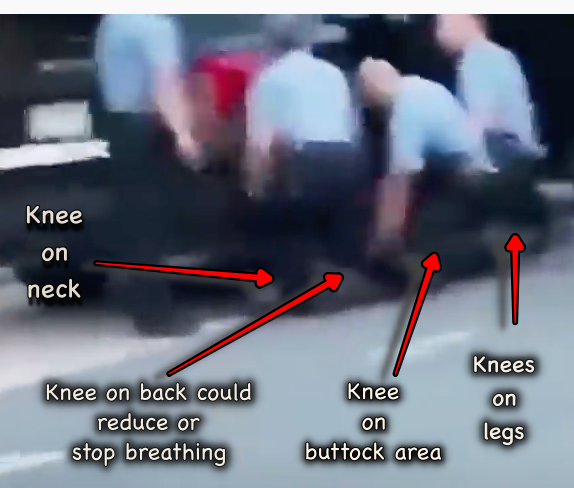
Imagine for a moment that the weight of the three officers wearing full gear totaled approximately 600 lbs. Now consider how a python or anaconda captures its prey and then squeezes and squeezes and squeezes until its victim’s circulatory system shuts down. The prey’s ability to adequately inhale and exhale gradually diminishes. It’s a crushing sort of death that with each exhale the pressure against the body prevents the lungs from inflating. Then another exhalation. “I can’t Breathe.” No inhalation. Another tightening. An exhale. “I … can’t … breathe …” A squeeze. A tiny exhalation. And …
Restraint Asphyxia – when someone is placed on their stomach without the means to shift position(s), the abdomen cannot expand. As a result, the diaphragm can no lunger function and the brain can become starved of oxygen. If the condition is allowed to continue, death is imminent.
Did Chauvin murder George Floyd in cold blood, in full view of numerous witnesses? Was he indeed that stupid and callous? Or, in his mind did he honestly believe he was doing the right thing as the situation dictated?
It is my opinion that there is no sound reason for Chauvin’s actions, and I believe we’ll soon see the defendant wearing a state prison uniform while residing in segregation. If convicted, I cannot imagine that he’d ever be safe in general population. At least not for a very long time. He’s a marked man.
Minneapolis Police Department Use of Force Policy
At the time of George Floyd’s death, the Minneapolis Police Department’s use of force policy permitted the use of neck restraints in certain circumstances.
5-311 USE OF NECK RESTRAINTS AND CHOKE HOLDS (10/16/02) (08/17/07) (10/01/10) (04/16/12)
DEFINITIONS I.
Choke Hold: Deadly force option. Defined as applying direct pressure on a person’s trachea or airway (front of the neck), blocking or obstructing the airway (04/16/12)
Neck Restraint: Non-deadly force option. Defined as compressing one or both sides of a person’s neck with an arm or leg, without applying direct pressure to the trachea or airway (front of the neck). Only sworn employees who have received training from the MPD Training Unit are authorized to use neck restraints. The MPD authorizes two types of neck restraints: Conscious Neck Restraint and Unconscious Neck Restraint. (04/16/12)
Conscious Neck Restraint: The subject is placed in a neck restraint with intent to control, and not to render the subject unconscious, by only applying light to moderate pressure. (04/16/12)
Unconscious Neck Restraint: The subject is placed in a neck restraint with the intention of rendering the person unconscious by applying adequate pressure. (04/16/12)
PROCEDURES/REGULATIONS II.
- The Conscious Neck Restraint may be used against a subject who is actively resisting. (04/16/12)
- The Unconscious Neck Restraint shall only be applied in the following circumstances: (04/16/12)
- On a subject who is exhibiting active aggression, or;
- For life saving purposes, or;
- On a subject who is exhibiting active resistance in order to gain control of the subject; and if lesser attempts at control have been or would likely be ineffective.
- Neck restraints shall not be used against subjects who are passively resisting as defined by policy. (04/16/12)
- After Care Guidelines (04/16/12)
- After a neck restraint or choke hold has been used on a subject, sworn MPD employees shall keep them under close observation until they are released to medical or other law enforcement personnel.
- An officer who has used a neck restraint or choke hold shall inform individuals accepting custody of the subject, that the technique was used on the subject.









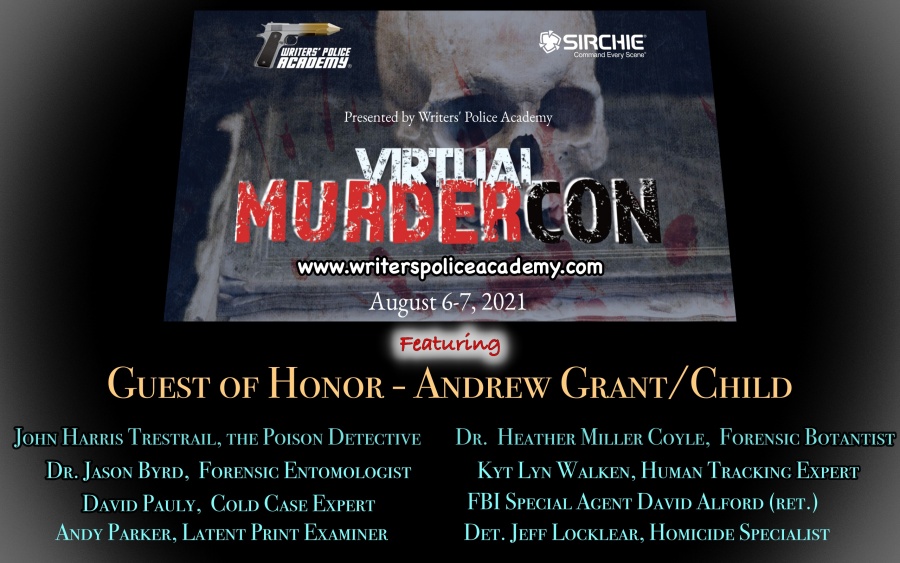


 “I meant the blue house on River Road, the first one on the right past the old oak tree, not the first one on the left. It was an honest mistake. Oops!”
“I meant the blue house on River Road, the first one on the right past the old oak tree, not the first one on the left. It was an honest mistake. Oops!”




